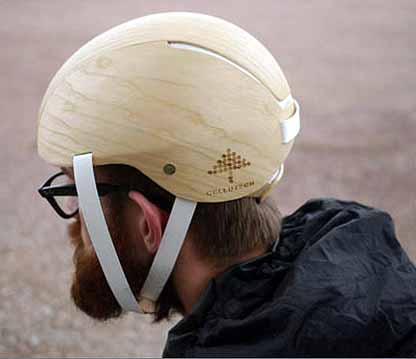Wood Nanofibers Used to Create Biodegradable Alternative to Styrofoam

In what looks like an ordinary bicycle helmet, Swedish designers have replaced Styrofoam with a new shock-absorbing material made with renewable and biodegradable wood-based material.
Researcher Lars Wågberg, a professor in Fibre Technology at Stockholm's KTH Royal Institute of Technology, Sweden, said the wood-based foam material offers comparable properties to Styrofoam.
This prototype bicycle helmet will protect your head with a biodegradable and renewable alternative to hazardous Styrofoam. The shock-absorbing foam material inside was developed at KTH Royal Institute of Technology, and it is one of the key features of an entirely wood-sourced helmet.
"But even better, it is from a totally renewable resource — something that we can produce from the forest," Wågberg says.
That's a big plus for a country where forests are planted and harvested continuously, much like any other cash crop.
Trademarked under the name, Cellufoam, the material was developed by Wågberg together with Lennart Bergström, professor in Material Chemistry at Stockholm University, and Nicholas Tchang Cervin, a former PhD student at KTH, in the Wallenberg Wood Science Center (WWSC).
The helmet concept is intended to draw attention to the possibilities of using wood cellulose as a sustainable alternative to Styrofoam and other foams from synthetic polymers. Wågberg said the last five years of Cellufoam research has been funded by the WWSC and Cellutech with the confidence that it will become possible to take the material to market scale soon. WWSC is a joint research center between KTH and Chalmers University; it is hosted at KTH and financed by the Knut and Alice Wallenberg Research Foundation.
Sweden certainly has the resources to support the commercial ambition for wood-based materials. "The Swedish forest industry is planting more trees than we harvest," Wågberg added.
The production begins with wood cellulose nanofibres, or fibrils, which are modified and mixed with a foaming agent water and air. Through the process of Pickering stabilization, these particles stabilize the air-bubbles in a way that is much better than by using simple surfactants, he said.
While the Cellufoam is being showcased as a bicycle helmet material, Wågberg says that by using different surface treatments and combinations with other material components, it could also be suitable for flame retardant materials, water filtration, and antibacterial material.
"It's really up to the imagination," he said. "In my experience, things like this wind up being used in ways you never expect.
TAPPI
http://www.tappi.org/
 In what looks like an ordinary bicycle helmet, Swedish designers have replaced Styrofoam with a new shock-absorbing material made with renewable and biodegradable wood-based material. Researcher Lars Wågberg, a professor in Fibre Technology at Stockholm's KTH Royal Institute of Technology, Sweden, said the wood-based foam material offers comparable properties to Styrofoam.
In what looks like an ordinary bicycle helmet, Swedish designers have replaced Styrofoam with a new shock-absorbing material made with renewable and biodegradable wood-based material. Researcher Lars Wågberg, a professor in Fibre Technology at Stockholm's KTH Royal Institute of Technology, Sweden, said the wood-based foam material offers comparable properties to Styrofoam.